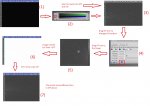I want to do a stretch that is the same as the STF function.
My understanding is that I can do this by doing an STF, then dragging the triangle to the HT process to copy the settings, then drag the HT process triangle to the image (and then un-doing the original STF). I feel like I have done this before, but the results on a DARK are not as I am expecting.
I took some screen shots of what I am doing to hopefully help illustrate what I am doing.
Thanks,
--Ryan
My understanding is that I can do this by doing an STF, then dragging the triangle to the HT process to copy the settings, then drag the HT process triangle to the image (and then un-doing the original STF). I feel like I have done this before, but the results on a DARK are not as I am expecting.
I took some screen shots of what I am doing to hopefully help illustrate what I am doing.
Thanks,
--Ryan

